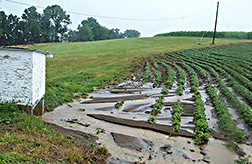This page has been archived and is being provided for reference purposes only. The page is no longer being updated, and therefore, links on the page may be invalid.
|
Read the magazine story to find out more. |
|
|
A Rare-Earth Approach to Tracking Erosion
By Luis PonsJune 10, 2005
Two Agricultural Research Service (ARS) scientists believe that rare-earth elements may be the best tool for tracking--and pinpointing sources of--costly soil erosion.
Hydrologist John Zhang and agricultural engineer Mark Nearing of ARS like these compounds because they can be used quickly, accurately and safely to track erosion. It was Nearing who introduced the technology here from China.
Rare-earth elements, which are listed in their own niche of the Periodic Table of the Elements, are actually abundant in Earth's crust. But in soil, they're usually found only in tiny, trace amounts. According to Zhang, the trick to using them to track erosion is to place enough tracer in the soil so that its concentration in collected sediment is about
three times its usual concentration.
Zhang and Nearing mix them with soil and distribute them with a device similar to a fertilizer spreader. Later, in the lab, they detect the elements in sediment through a spectrometry procedure using a new extraction technique that they developed.
There are 30 rare-earth elements. The scientists are working with the following lanthanide oxides: lanthanum, cerium, praseodymium, neodymium, samarium and gadolinium.
The researchers said the fine-powder elements are a more effective tool for tracking movement of eroding sediment than what's currently the most widely used tracer: minuscule amounts of the radioactive element cesium (137Cs) that originated from nuclear-bomb testing and spread across the landscape via atmospheric wind currents.
The scientists started this work when they were with ARS' National Soil Erosion Research Laboratory in West Lafayette, Ind. Zhang now works at the ARS Grazinglands Research Laboratory in El Reno, Okla., and Nearing is with the ARS Southwest Watershed Research Center in Tucson, Ariz.
Read more about the research in the June 2005 issue of Agricultural Research magazine.
ARS is the U.S. Department of Agriculture's chief in-house scientific research agency.


